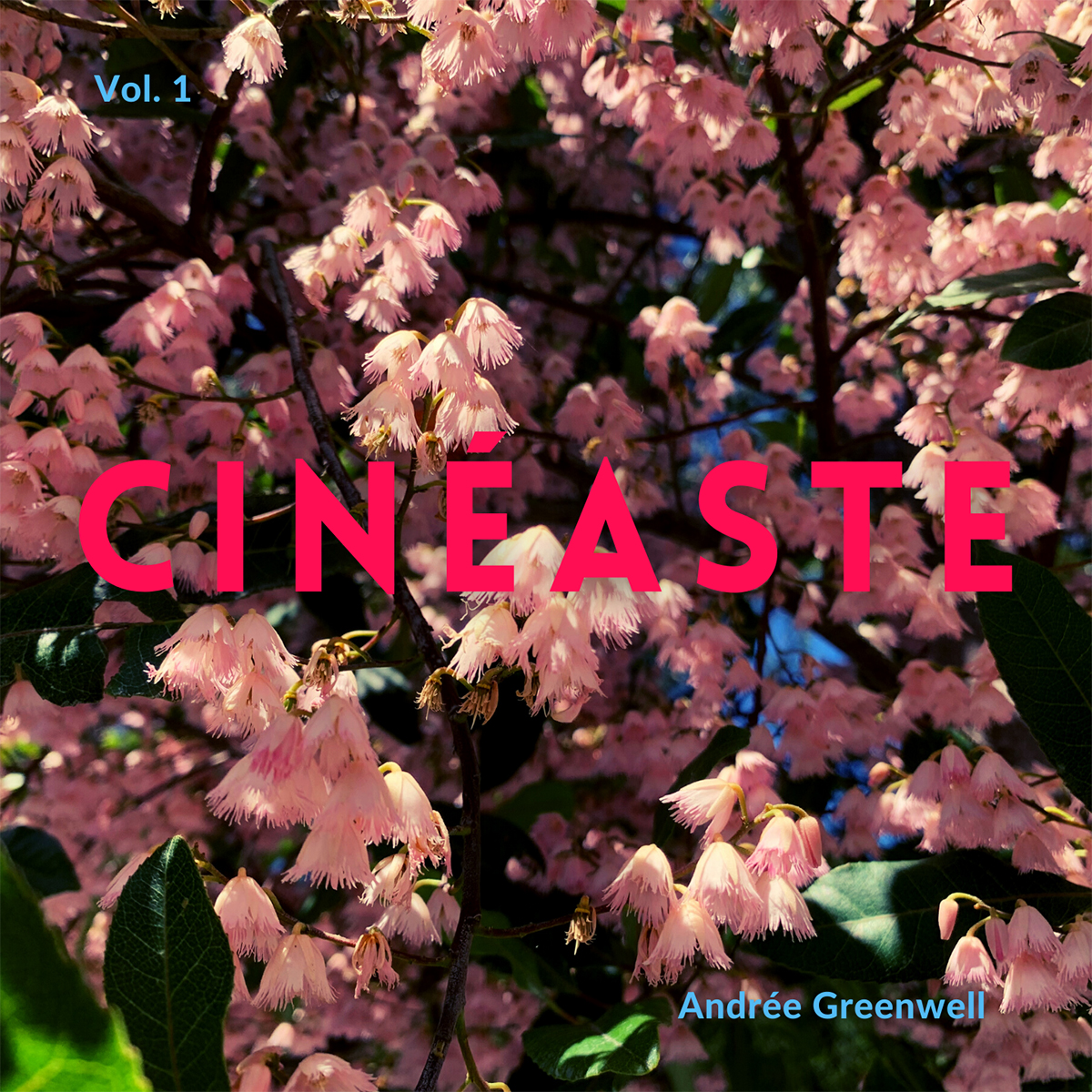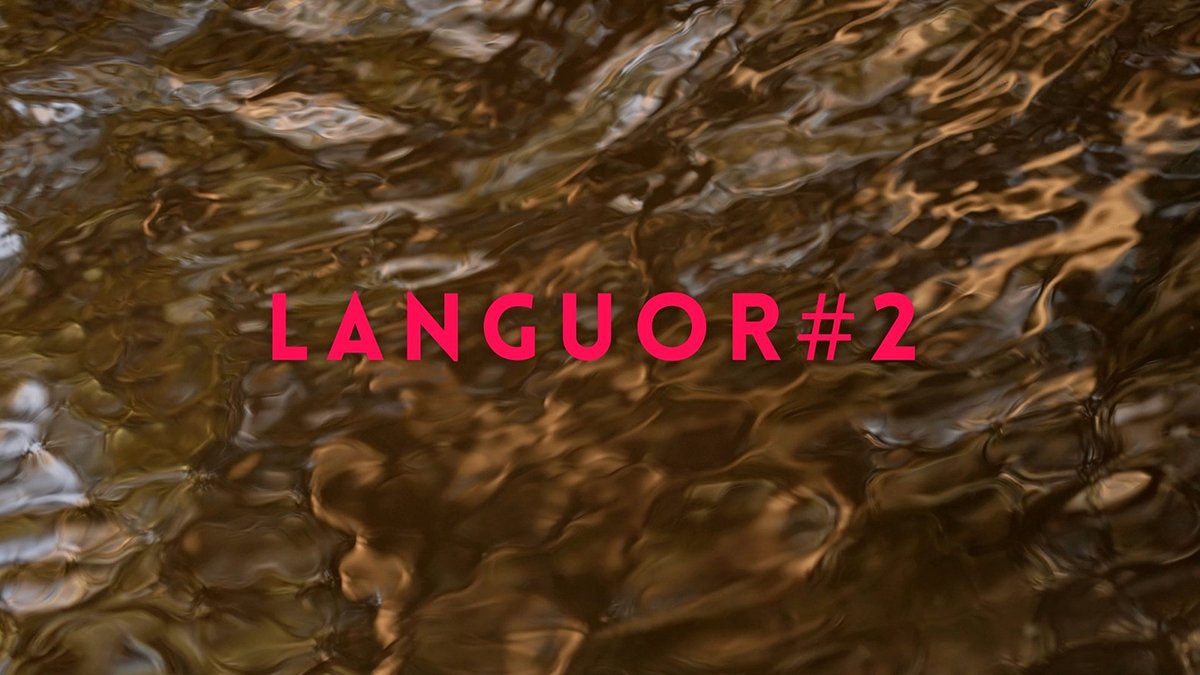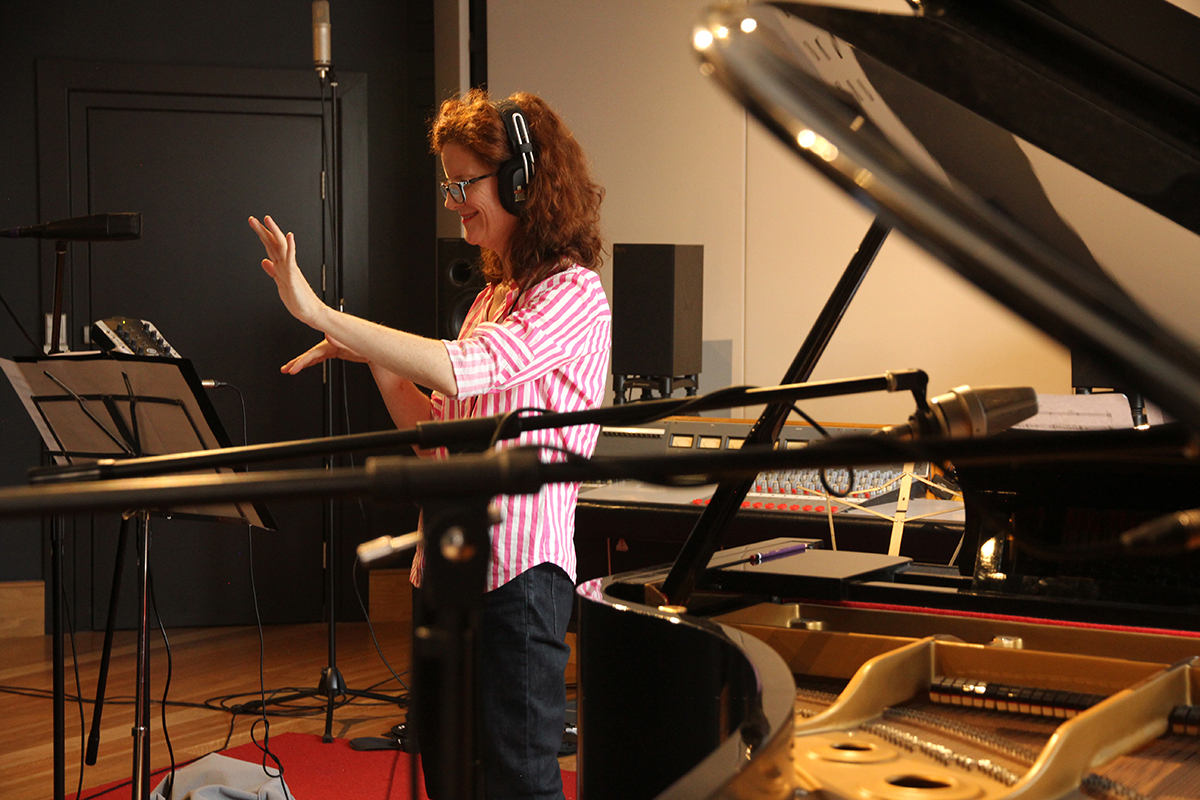October 2021
At first glance the tracklist for composer Andrée Greenwell’s Cinéaste suggests the album might be the soundtrack for a film, its 22 entries running from a mere 0’55” to a maximum of 3’03” with most unfolding in around a couple of minutes. It’s not, but it is in good part movie driven, featuring Greenwell’s own film scores, rescorings and pieces inspired by film composers as well as kindred compositions she has created for theatre companies and her own multimedia works. Perhaps music from her short films LAQUIEM and MEDUSAHEAD will find their way into Volume 2.
Cinéaste Vol. 1 is an assemblage that allows Greenwell to lovingly reflect on the idiom of film scoring and to inventively refract her own compositions, yielding aural gems that glitter then fade all too soon. Hit replay and they sparkle again: riffs, ostinatos, hooks and soundscapes, the stuff of movies actual and imagined.
Of course, such brevity can be a virtue, whether it’s in, say, the Preludes and Fugues of Bach and Shostakovitch or in scoring for film where tight cueing and desired immediacy of affect often require short, repeatable, mutable compositions which, at their best, have a cellular cohesiveness.
Discursion: soundtrack lover
A cinéaste is a cinephile is a film lover. According to Merriam-Webster, the term was borrowed by Americans in the 1920s from the French who had attached the -aste suffix (as in gymnaste and enthousiaste) to Ciné (cinema). Originally applied to filmmakers it was later extended to film lovers and buffs in general. Having scored films, including her own, Greenwell is a cinéaste insider. I’m an outsider, but a long-term soundtrack fancier (the term soundtrack was made common in the 1940s with the sale of records of film music minus dialogue and effects). One of my first 78rpm shellac disk purchases was of a rather grim, brief passage from the score of the three-hour (barely) historical epic Quo Vadis (1951), my first conscious taste of symphonic music. Its composer, the great American-Hungarian composer Miklós Rózsa (who scored everything from Double Indemnity, The Lost Weekend and The Killers to Ben Hur and El Cid), inhabited both film and classical music worlds. Sadly, someone sat on and broke the record. Mum, though a chronic film fan, thought the music depressing and wouldn’t have it played within her hearing.
I’ve felt attuned to film music ever since, to the scores of Herrmann, Tiomkin, Raksin, Legrand, Newman, Takamitsu, Morricone, Rota, Goldsmith and more recently, among others, Carter Burwell (for the Coen Brothers) and Mychael Danna (for Atom Egoyan). Burwell’s sometimes spare orchestrations and unusual choice of instruments have a particular appeal as do Matthieu Chabrol’s wry modernist chamber ensemble scorings, perfect matches for his father Claude’s many films from 1979 to 2009. Spotify has allowed me to revisit and expand my appreciation of many of these composers and to experience scores by newer ones for film and especially television, including the remarkably inventive Nicolas Brittell (Succession, The Underground Railroad — a superb exemplar of the intricate melding of composition and sound design) and the growing number of women writing for film and television in the UK and USA (Rachel Portman, Debbie Wiseman, Mica Levi [Under the Skin], Sophie Waller-Bridge, Tamar-kali [Mudbound]) and in Australia (Lisa Gerrard, Caitlin Yeo [Kriv Stenders’ Danger Close: The Battle of Long Tan], Elena Kats-Chernin, Bryony Marks [Noise] and Felicity Wilcox [Reindeer in my Saami Heart]). It’s a great time for soundtrack fanciers, for access and the thrill of hearing increasing experimentation in composition and sound design.
What’s the score?
Full of variety, Cinéaste Vol. 1 comprises companion pieces and fascinating juxtapositions. The immediately engaging opening tracks, Trio and Outing, for example, share structural similarities, briskly if unhurriedly unfolding with simple ostinato overlays, including foregrounded musing strings, until dissolving into eerie electronic surge and fade — with a haunting, lingering piano and distant, distorting voices in the darker toned Outing.
In a reversal of process, Greenwell commissioned Sydney video artist John Gillies to respond to Trio with a film for the launch of the album (held over until 2022). The result is a precise and subtle engagement with the rhythms of the score (Gillies is also a drummer), surveying a rural landscape and the clouds above interpolated with closeups of white moths caught in a web, the last featuring the arrival of a hungry spider as the music turns eerie. While film music usually underlines, amplifies or even counterpoints intended affect, here it’s film illustrating to what end this music might be used, with moments of unsettling rapid cutting that presage the ending. This meshes with Greenwell’s own feeling about Outing, as she writes on the online platform Bandcamp: “I like the sense of motion and anticipation in this piece, and the instrumentation reminds me of [Michel] Legrand’s memorable score for The Go Between, through a palette of thistles and with a couple of sharp unexpected turns at its end.”
With its spacious droning, sweet piano-belling and folk-like intertwining violins (Veronique Serret), Cinéaste’s third track, Herding (at an all too short 1’19”), references Greenwell’s score for American indie director Anne-Marie-Hess’s feature documentary Refugio: TX. Greenwell writes, “There are gorgeous moody images of rural farms in Texas, and I recall the slow-mo trek of the cattle approaching the camera …” It’s the kind of music found in many a Western these days harking back to Appalachian, English and Irish roots, delivered here with a distinctive elegiac warmth. Greenwell tells me she met Hess in 2002 when in an artist residency at Château de La Napoule in France. They became friends and Hess came to Australia for the recording and mixing with engineer Shane Fahey.
Writing about Langour#1, Greenwell invokes a different kind of landscape, describing the piece as: “An expansive post-minimal track that suggests an epic poetic of landscape; so I am thinking about film makers I admire greatly in its writing — Gus Van Sant, Jim Jarmusch and Jane Campion.” A contemplative piano is joined with a distant, long-noted, raw-edged electric guitar (think early Terj Rypdal on ECM) played by David Trumpmanis and soft string phrasings, the overall tone ambiently in tune with the previous track, Herding.
With big brass chords (think Jeff Beal’s scoring for House of Cards) slowly sweeping from ear to ear over a pondering piano, neatly plucked strings and dark bass, Secret Theme sounds like the secondary theme for a big production TV series about power and politics. For all its orchestral feel it’s solely the product of Greenwell’s sequencing, keyboards, electronica and mixing. Search into the Eerie, which follows, is an apt pairing, darkening the mood with thumping drum, querulously riffing strings, sustained bass notes and nervy, rattling percussion. The bass climbs, then drops out leaving behind carolling strings and electronically chopped-up tinkling, like some powerful force dissipating into a vacuum.
With its unrelenting crashing percussion, scattering glass, high-reverb soaring and subsequent screaming (Ruth Wells tenor saxophone) over an anxious, almost heart-beat bass and a bed of spooky swirling electronics, Fire [Insto Redux] is the dramatic highlight of the album. Greenwell writes, “I really went with a literal violence in my use of sound and EQ’d bass in this one.” She tells me that it’s the music track for the Fire from Greenwell’s podcast Listen to Me (2018), originally with spoken word by the late Candy Royalle. It feels satisfyingly complete at 2’13” even if shorter than the original.
Lee McIver on flugel horn plays on the solemnly bugle-ish Flugel Haul and on Gentle Rise #1 in which an affecting melody — a sweet ‘rising’ seemingly plucked high on bass strings — and a pulsing female choral one-note la-la-la-ing are joined very briefly by horn and trombone (Jacob Parks) providing a melancholy ostinato. Greenwell, again alluding to “poetic landscape,” had been “thinking about Gus Van Sant and one of my favourite songwriters Beck, sunshine and flare, maybe peeping out from some twilight…”
In Languor #2 (Greenwell’s “cine-score reimagining of her music for 2071 – a performance about climate change, Seymour Centre, 2017”) the electric guitar heard in number #1 initially sings a ringing, widely-spaced four-note suspended phrase over a mesmeric slow, electronic swirl, then rises sweetly in pitch before dipping down into a lingering yearning. Deftly constructed and at 3’03” it’s one of the album’s most satisfying tracks. Greenwell’s reference points, she writes, are David Lynch (Eraserhead and the band Tuxedo Moon) and Angelo Badalamenti — hence Trumpmanis’s spacious, darkly ethereal guitar (Greenwell does an excellent, minimalist string-pulsed cover of Badalamenti’s Falling from Twin Peaks on her album Gothic on Bandcamp). The video for Languor #2, edited by James Manché from cinematography by Steve Macdonald, has the restless, swirling waters of the NSW south coast alternating with refracted, abstracted light.
In Spanish Cowboy, another of her pieces for Anne-Marie Hess’s Refugio: Tx, Greenwell delivers, as she puts it, “a sultry-minimal-cowboy-new-folk piece with a little acidic electro turn.” A Morricone-ish warping electric guitar (lap steel, electric guitars Tim Malfroy) sings eloquently over a horse-plodding three-note acoustic guitar foundation and plangent brass until strings and trumpet take over in a brief Glassian exit. It’s a beautiful track, well deserving of more than its 1’48” playing time, but memorable nonetheless, especially for the guitar writing. The accompanying video (editor Manché) features brief, quick-paced glimpses of ranch labour taken from Refugio: TX counterpointed with the music’s leisurely unfolding. Meeting, which follows Spanish Cowboy, deploys the same guitar style, this time the instrument spaciously musing before dropping out for cello, then violin, then trumpet and drumkit warmly coalescing, the guitar then chording along.
Secret Texture, entirely produced and played by Greenwell in her home studio, was inspired by the score by Kyle Dixon and Michael Stein for the wonderfully bracing American TV series Stranger Things. When her foregrounded percussion kicks in at the one-minute mark and the electronics eerily ring in the ears on the way to the end, Andrée Greenwell’s version of this kind of sci-fi scoring feels fresher and sharper than the denser Stranger Things score.
Two of the most beautiful tracks on the album are Piano Tendrils and Gentle Rise #2, played, sequenced and mixed by Greenwell. The first is blessed with tender melodic writing for slowly paced, high, abstracted piano notes pinging against pizzicato and deep long-phrased strings and a bird-like flute hovering delicately above. The second deploys a similar melodic pinging, with McIver initially repeating single notes on trumpet before sketching a yearning ostinato as the piece closes.
Maria Walks (Instro Redux) comprises the instrumental and backup vocals from Maria Walks Amid the Thorns which was part of Greenwell’s Gothic album. Like Secret Texture and the endings of Trio and Outing, this track is on the cosmological scale with its insect-like electronic distortions and reversed, increasingly layered female chorus (from Julia County’s original vocals) and David Trumpmanis’s reverberant electric guitar texturing.
The original, Maria Walks Amid the Thorns, can be experienced on YouTube with its haunting singing and eerie motion graphics by the UK-based Australian media artist Michaela French.
Castlecrag and Steinway Hall, reveal a different compositional voice, demonstrating Greenwell’s range. They’re accomplished, acoustic string-driven post-minimalist tracks from Greenwell’s score for Belinda Mason’s City of Dreams (2000), a documentary about artist and architect Marion Mahoney Griffin.
The album’s penultimate track, a favourite of mine, the plangent Notre Père (instro) from Greenwell’s acoustic score for Sydney Theatre Company’s Cyrano (1999). As in Meeting, the cumulative interplay of solo musings and subsequent collective chording — here trumpet, violin, cello, double bass — evoke dramatic introspection and, as in Piano Tendrils, the piece is graced with affecting melodic invention.
Cinéaste is blessed with a cast of superior musicians and features tracks that, for all their brevity, are far more engaging than the predictable, often heavily textured ostinatos of many a contemporary soundtrack. Greenwell deftly layers her patterning, delivering spare, affecting variations and melodies made with intriguing instrumental, electronic and spatial choices. Cinéaste Vol 1 will doubtless serve as an excellent calling card for Greenwell to take to directors and producers while offering soundtrack enthusiasts much to ponder about the idiom and, for other listeners, the pleasures of the rural, poetic and theatrical vistas conjured, and films actual and imagined.
Andrée Greenwell, Cinéaste Vol 1 is available on Apple Music, Spotify and Bandcamp
From the Archive: RealTime reviews of works by Andrée Greenwell
Medusahead, Confessions of a Decapitated Soprano, RealTime 33, Oct-Nov 1999
Medusahead, Confessions of a Decapitated Soprano, RealTime 51, Oct-Nov 2002
Dreaming Transportation, RealTime 53, Feb-March 2003
The Hanging of Jean Lee, RealTime 75, Oct-Nov 2006
For STC’s Venus & Adonis, RealTime 90, April-May 2009
The Hanging of Jean Lee, RealTime 19, Feb-March 2014
For Decibel’s After Julia, RealTime issue 124, Dec-Jan 2014
Gothic, RealTime issue 28 Aug-Sept 2015
Listen to Me, RealTime online 1 Aug 2018
Top image credit: Andrée Greenwell, photo James Manché






